5G and Lack of Resistance: Modeling Political Activism in Canada - as a Data Science Project
A data science framework defining five Canadian archetypes through their responses to 5G, lockdowns, and mandatory vaccination.
Preface
This work is a direct follow-up to the conversation I tried to initiate after publishing my previous piece documenting a troubling fact: 5G towers have been installed near children’s playgrounds in Ottawa—specifically in the Beacon Hill community.
I first became aware of this through a post on the Beacon Hill Community Association Facebook group, where someone shared a photo of the new tower. In response, I submitted a post to the group myself, inviting residents to consider signing or helping prepare a petition to request the relocation of these towers away from playgrounds and to demand an investigation into potential health risks—particularly for children who play daily within close range.
However, my post was never approved by the group administrators.
This was disappointing, though not surprising. I did manage to leave a comment on the original post, expressing concern about the well-documented health implications of prolonged 5G exposure, especially for vulnerable populations. But even then, no one engaged …and the group admin turned off commenting on this post.
This reaction is what prompted me to start this work and write this article.
As a data scientist, I wanted to understand not just what is happening, but why no one is willing to talk about it. Why does something so clearly impactful—so deeply tied to our health, our children, and our autonomy—provoke not protest or discussion, but indifference?
In this article, I develop a model of public behavior to explain the deepening cultural apathy in Canada around issues of serious concern, like 5G, lockdowns, and vaccine mandates. It aims to provide an analytical exploration of a social phenomenon: how public passivity is shaped, reinforced, and maintained—even when our neighborhoods, our children, and our futures are visibly affected.
Whether we like it or not, many Canadians seem to believe that these changes—this rapid, top-down technological invasion of everyday life—are unavoidable. That resistance is either inappropriate or futile. But I argue that such fatalism isn’t a natural outcome. It’s a manufactured condition—and one we must learn to decode if we hope to reclaim the right to question, resist, and protect what matters most.
Part 1: A Citizen’s Observations
When a new shopping plaza is proposed, you get a notice. When a bridge threatens to redirect truck traffic through your neighborhood, there’s a townhall. When a school is rezoned, a flurry of community responses follow.
But when a 5G tower emitting high-frequency electromagnetic radiation is quietly installed next to a children's playground, there’s… nothing. No notice. No meeting. No protest. Not even awareness.
This silence is not just puzzling—it is deeply troubling.
The Usual Process: Public Consultation for Physical Infrastructure
Canada prides itself on local engagement. Before any major development project, municipalities are required to:
Notify nearby residents
Post visible signs on the site
Invite public feedback through open houses or consultation periods
Citizens routinely respond. Consider the East-end Ottawa Bridge Proposal, where communities mobilized to stop a traffic reroute that would have brought heavy trucks through a quiet residential neighborhood. Residents rallied, organized petitions, and succeeded in stopping the bridge.
The 5G Exception: No Transparency, No Participation
In contrast, 5G towers are often installed with no notice at all. Why?
Small-cell towers under 15 meters are exempt from federal consultation.
Installations on utility poles or rooftops often bypass zoning laws.
Health Canada’s Safety Code 6 allows deployment as long as energy levels remain under their outdated thermal-only exposure limits.
That’s it. No warning. No signage. No right to object.
A recent example in Ottawa’s Beacon Hill neighborhood proves the point. A 5G tower was erected less than 10 meters from a public playground. When a concerned resident posted a photo in a local Facebook group, most users didn’t even recognize the structure as a 5G antenna. Comments joked about finally getting better Netflix signal. No one expressed concern over lack of consultation, and no one asked why the tower was placed so close to where children play.
Two Parallels
This passive response isn’t accidental—it follows a pattern seen elsewhere. Two major examples illustrate how expert voices are censored and media narratives manufactured to maintain public compliance:
1. Lockdowns
The effects of prolonged school closures during COVID-19 lockdowns have been devastating:
Mental health crises in youth
Learning loss and social regression
Economic destruction of small businesses
Yet this massive social experiment—implemented in most countries with no prior evidence and no third-party assessment—was publicly unchallenged. Only Sweden, which refused to follow WHO lockdown guidance, has publicly assessed and taken responsibility for its decisions.
In contrast, in Canada, the issue has been all but buried. Mainstream media rarely acknowledge the long-term toll, and those who criticize the lockdown strategy are dismissed, ridiculed, or silenced. Even now, there is no accountability.
2. mRNA Vaccines
Despite being rushed to market with no long-term studies and no true placebo-controlled trials, mRNA vaccines were aggressively promoted. Now, as adverse effects including death and serious injury emerge, the experts who warned us are still being:
Excluded from public discourse
Mocked as conspiracy theorists
Sanctioned or threatened within professional bodies
Independent voices were pushed out, while media narratives—funded directly or indirectly by pharmaceutical companies and government campaigns—told the public what to believe.
Why This Explains the 5G Silence
The same pattern explains the lack of activism around 5G towers:
Experts raising EMF concerns are deplatformed or dismissed.
No independent media coverage exists.
People assume it’s safe, simply because it’s unchallenged.
This absence of critical thought is not a failure of intelligence—it’s a result of social engineering. When only one narrative is allowed to circulate, most people adopt it.
And so, the placement of high-frequency radiation devices next to homes and playgrounds goes completely unnoticed. Not because it's safe. But because the machine that manufactures public belief has decided the public doesn’t need to know.
Discussion: Who Is Really in Control?
This raises a larger question: Who controls what enters your neighborhood? Your home? Your body? Your child’s school?
Increasingly, it’s not local communities. It’s not your city council. It’s not even your national government. It’s mega-corporations with global reach—telecoms, pharmaceutical giants, digital conglomerates—who:
Design the technology
Fund the science
Shape the policies
Own the media
They manufacture not just devices, but perception. Not just products, but consent.
If you feel like your life is being shaped by forces you can’t question, you’re not imagining it. This is how control works: not by force, but by narrative. You are made to feel crazy for noticing. Or cruel. Or conspiratorial.
But the truth is simple: if people aren’t allowed to ask questions, the answers don’t matter.
We are not sheep—but we are being treated like them. Herded by headlines, numbed by distractions, kept docile by exhaustion and fear.
It’s time to reclaim our agency, our neighborhoods, and our future. If we cannot even discuss what is being installed above our homes and beside our children, we have already surrendered the most basic element of democracy: the right to know and the right to say no.
So what we can do about it? Lets start by building a model!
As a data scientist, I aim at developing a typological model to understand how public passivity is manufactured so that it can help to see what needs to be done to make our communities more active.
Part 2: Modeling Citizens Level of Activism as a Data Science project
Canadians can be broadly grouped into five behavioral archetypes when it comes to the 5G rollout (and similar globalist-driven technopolitical issues):
Type 1. The Unaware
These individuals simply don’t see the tower. Or if they do, they don’t know what it is or what it does. They assume it’s just another light pole or street fixture.
Type 2. The Trustful Passive
They believe that if the government or telecoms are doing it, it must be safe. This group places implicit faith in regulatory systems, even when those systems are outdated or opaque.
Type 3. The Fatigued or Disengaged
They might know—but they’re too burned out to act. After years of pandemic stress, financial strain, and information overload, civic activism feels like one more burden they can’t carry.
Type 4. The Concerned but Discouraged and Threatened
These are those who see the danger, research the facts, and try to act. But they are discouraged by the apathy around them and sometimes even punished for speaking up. In many cases, they fear job loss, reputational harm, or social isolation for challenging state narratives or questioning corporate-sponsored messaging. Their silence now is not from lack of care—but from heartbreak and self-protection.
Type 5: The Concerned and Active
Finally, there are those who do persist, speak out, and take action—despite social, legal, and professional risk.
Problem Statement
In the past five years, Canadians have lived through three transformational policy campaigns:
The rollout of 5G towers, often placed near homes and schools without public consultation.
National COVID-19 lockdowns, which disrupted education, destroyed small businesses, and damaged youth development.
Mass mandates of mRNA-based vaccines, promoted as safe despite limited long-term data and censorship of dissent.
Each initiative was:
Rapidly implemented with little public debate.
Justified as "for the greater good".
Shielded from critique by a compliant media environment.
Met with surprising silence from the public.
The data science question:
Why do so few Canadians resist, question, or even inquire about policies that so clearly affect every aspect of their lives?
Step 1: Modeling the Public Response and Citizens Level of Activism — The Canadian Apathy Model (CAM-5)
Using observational and behavioral logic, I developed a five-type typology to model Canadian responses across these policy areas. Each archetype reflects a cognitive-behavioral pattern observed in population response.
Type 1: The Unaware
They don’t see it. They don’t know it’s happening. If they notice a tower, they assume it's just a light pole.
Type 2: The Trustful Passive
Believe that if the government or a major institution does it, it must be good. Trust overrides inquiry.
Type 3: The Fatigued or Disengaged
They suspect something’s wrong but are too drained or distracted to act. The system has worn them down.
Type 4: The Concerned but Discouraged
They know. They care. But after being mocked, ignored, or threatened—they retreat in silence.
Type 5: The Concerned and Active
The smallest group. They persist, speak out, and take action—despite social, legal, and professional risk.
Step 2: Estimated Population Distribution by Policy Area
These numbers are estimated using:
Civic engagement trends
Media behavior
Public discourse suppression
Observational patterns from local and online communities
5G Infrastructure
Unaware (38%): Most people do not recognize 5G towers or know their function.
Trustful Passive (28%): Rely on Health Canada and telecom assurances.
Fatigued/Disengaged (20%): Have general distrust but don’t engage.
Concerned & Discouraged (10%): Aware but feel mocked or helpless.
Concerned & Active (4%): Continue pushing for public awareness despite opposition.
Lockdowns
Unaware (18%): Accept lockdowns as normal and necessary.
Trustful Passive (23%): Believe it saved lives—case closed.
Fatigued/Disengaged (28%): Know something was wrong, but exhausted.
Concerned & Discouraged (25%): Understand the damage, felt isolated.
Concerned & Active (6%): Fought back—organized petitions, protests, supported lawsuits.
Vaccine Mandates
Unaware (23%): Took the vaccine without understanding it was experimental.
Trustful Passive (28%): Believed it was safe and essential.
Fatigued/Disengaged (24%): Got vaccinated to avoid conflict, not conviction.
Concerned & Discouraged (20%): Saw the issues, stayed silent under pressure.
Concerned & Active (5%): Refused mandates, researched side effects, and warned others.
Step 3: Understanding the Apathy and Missing Resistance
The Common Playbook Behind All Three Policies
The main objective of this modeling exercise is to understand the mechanism of silence so it can be properly addressed when needed.
All three policies share common operational features:
Top-down global coordination (telecom consortiums and pharma alliances), WEF, WHO, WEF)
Framed as “for your safety”
Industry and Government funded Media Narrative Control
Expert Censorship
Absence of meaningful consultation
Information Control Flow
At the top:
WEF, WHO, IMF, multinational corporations.
⬇
Translated into policy by federal governments and public health agencies.
⬇
Distributed through corporate media, social media platforms, and educational systems.
⬇
Reinforced by local institutions: schools, sports clubs, workplaces.
⬇
Behavior shaped at the ground level—where most Canadians remain unaware, passive, or too tired to resist.
Mechanisms of control
Experts are censored or punished for dissent.
Media is funded to align with policy narratives.
Citizens are shamed or isolated if they speak out.
Institutional conformity is rewarded with stability.
Fatigue is weaponized—making resistance feel impossible.
Part 3: What’s Next - How to make our communities more active (Work in Progress)
The lack of resistance to 5G towers—just like the absence of mass outrage over lockdown harms or vaccine coercion—is not natural apathy. It is engineered through systems of information control, expert suppression, media funding, and psychological exhaustion.
And yet, a small group remains awake, vocal, and active. These are the Concerned and Active—those who persist, build communities, write articles like this one, and keep the flame of inquiry alive.
The question is how to help communities to have more such concerned and active citizen from the majority of those are unaware and passive.
Modeling the dynamics - How to Make changes to level of activism in a community
NB: This is work in Progress. It needs to show directions of transitions (modelled by edges) , and assign weights to them, which shows the chance of switching from one archetype (vertex) to another. Then the size of each vertex should be made proportional to the population size.
Here is the directed clique graph showing the influence pathways between the five archetypes. Each arrow represents the likelihood that one group can influence another, with probabilities labeled on the edges. [[ Ignore the numbers for now. ]]
And here is the transition matrix, where the numbers show the chance of transitioning from one state (vertex archetype) to another.
NB: The numbers are given just to illustrate the idea - they are generated by ChatGPT based on my lengthy interactions with it. But it generated still rather dumb estimates. These will need to be revised to be closer to reality. E.g. Unaware can become Aware, but the opposite is not true and so.
*** You are invited to provide your estimates for all archetype groups and transitions weights between them in Comments below ***
Appendix: Should There Be a Sixth Archetype? The Case of the Fatalistic Resigned
As the five-archetype model developed in this article was tested and refined, a sixth behavioral pattern has emerged in discussion: the fatalistically resigned—those who believe that resisting top-down changes is pointless because the outcome is already decided. These individuals may say:
“There’s nothing we can do about it.”
“Progress can’t be stopped.”
“They’re going to do it anyway.”
This raises the question: Does this group warrant a separate archetype?
Behavioral Analysis
Let’s compare this proposed sixth group with the five existing ones:
We observe that this sixth type overlaps heavily with two existing ones:
Fatigued/Disengaged, in terms of emotional exhaustion and withdrawal.
Concerned but Discouraged, in terms of knowing the problem but feeling powerless.
However, what sets the Fatalistic Resigned apart is their ideological belief in inevitability. Their inaction is not due to tiredness or fear—it’s philosophical. To them, history is controlled by unstoppable forces. They do not see themselves as agents of change.
Decision: Archetype or Subtype?
From a modeling perspective, the Fatalistic Resigned are best understood as a subtype within Concerned but Discouraged. They:
Are often educated or observant enough to know what’s happening.
Lack the emotional burnout of the Fatigued.
Differ from the Trustful in that they don’t think the policy is good—just that it’s unstoppable.
Their defining feature is resigned fatalism, which is a psychological endpoint that the Concerned but Discouraged may arrive at over time.
Conclusion
The sixth archetype—Fatalistic Resigned—does not need to be a separate class in the typology. Instead, it should be noted as a distinct expression of discouraged awareness within the Concerned but Discouraged category.
These individuals don’t disengage because they’re tired. They disengage because they’ve convinced themselves it’s already too late.
Their presence is important to acknowledge, particularly for strategy and outreach, but for clarity and model coherence, they are best treated as a critical internal variant within the existing framework.
Acknowledgment:
This article is written with assistance from ChatGPT based on multiple prompts (in English and Russian): "Write an article about the lack of public awareness and activism surrounding the installation of 5G towers, including a psychological breakdown of why people don’t respond, comparison with historical community mobilizations in Ottawa, and parallels to other issues where experts have been silenced and the public misinformed." All ideas and modeling are original, made by the author. Based on approximately 8000 words and 40 minutes of conversation with the author.
Disclaimer:
This article's opinions are that of the author, not of any institution. It is not for legal or medical advice.
Support This Work Across All Channels
If this article resonates with your concerns, share it with others. Awareness is the first step toward safety.
Follow the author here:
🔹 LinkedIn
🔹 YouTube
🔹 Substack
🔹 Twitter/X


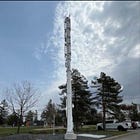
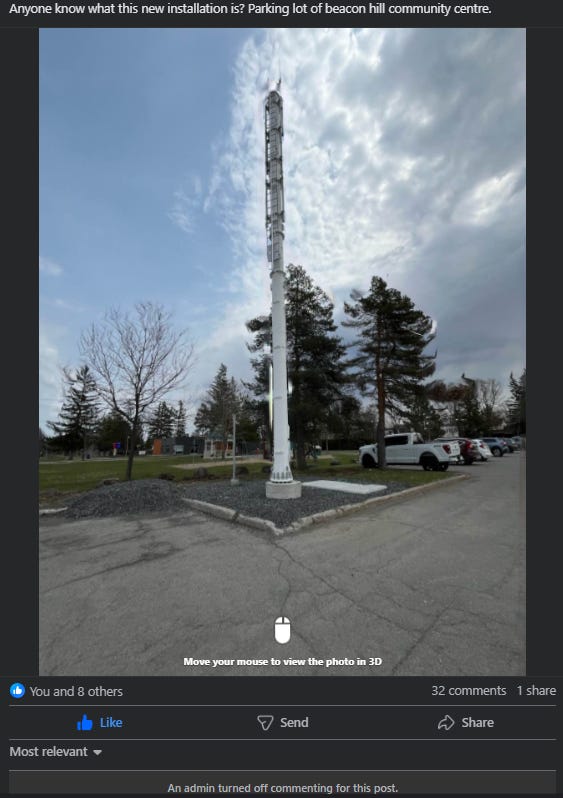
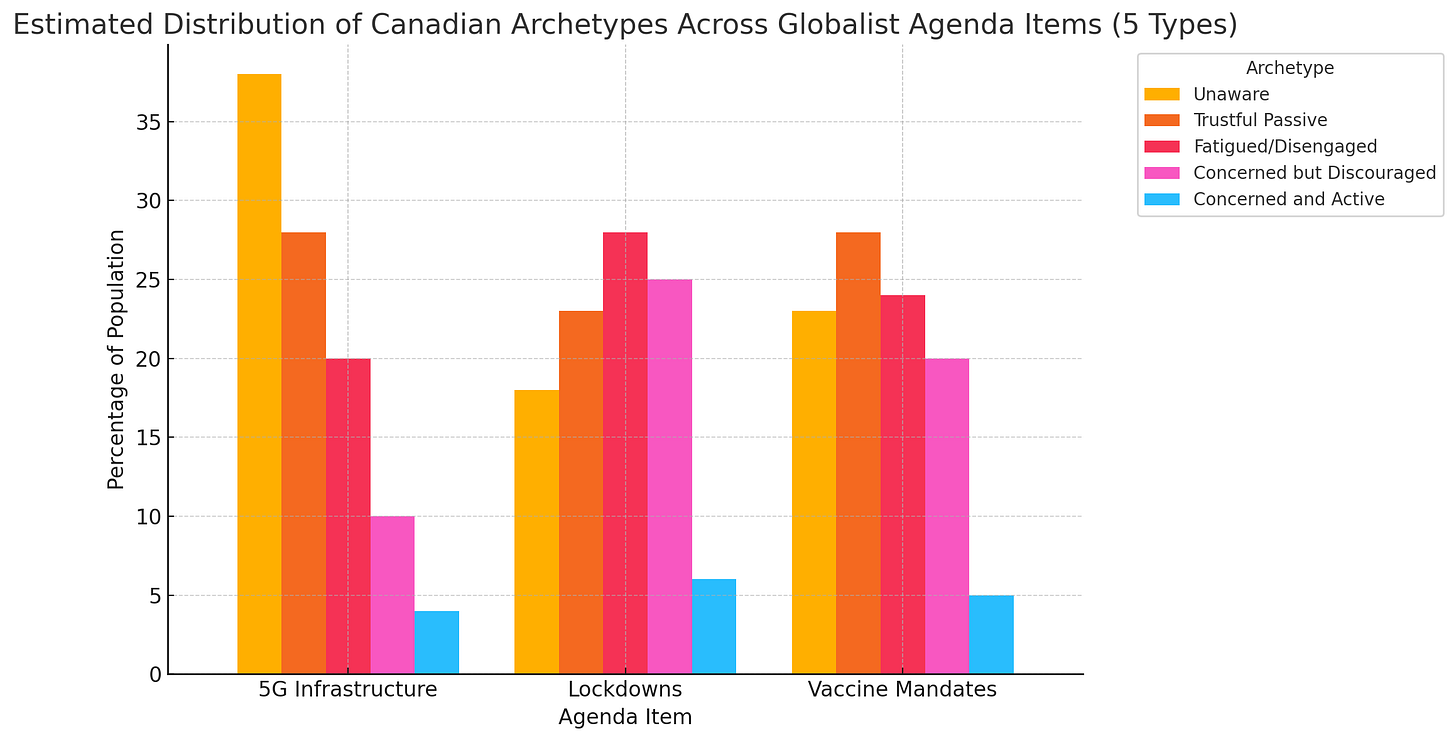
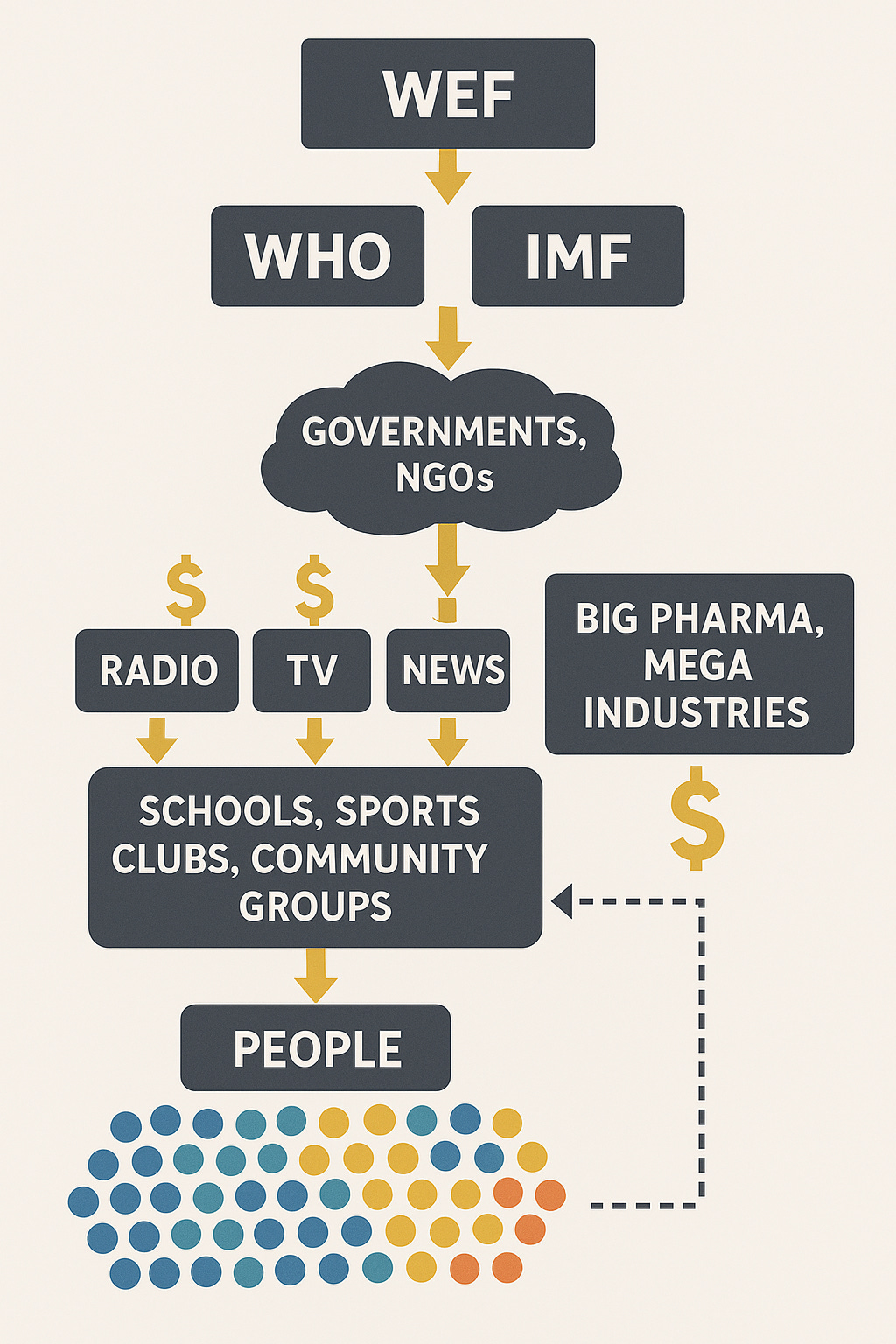
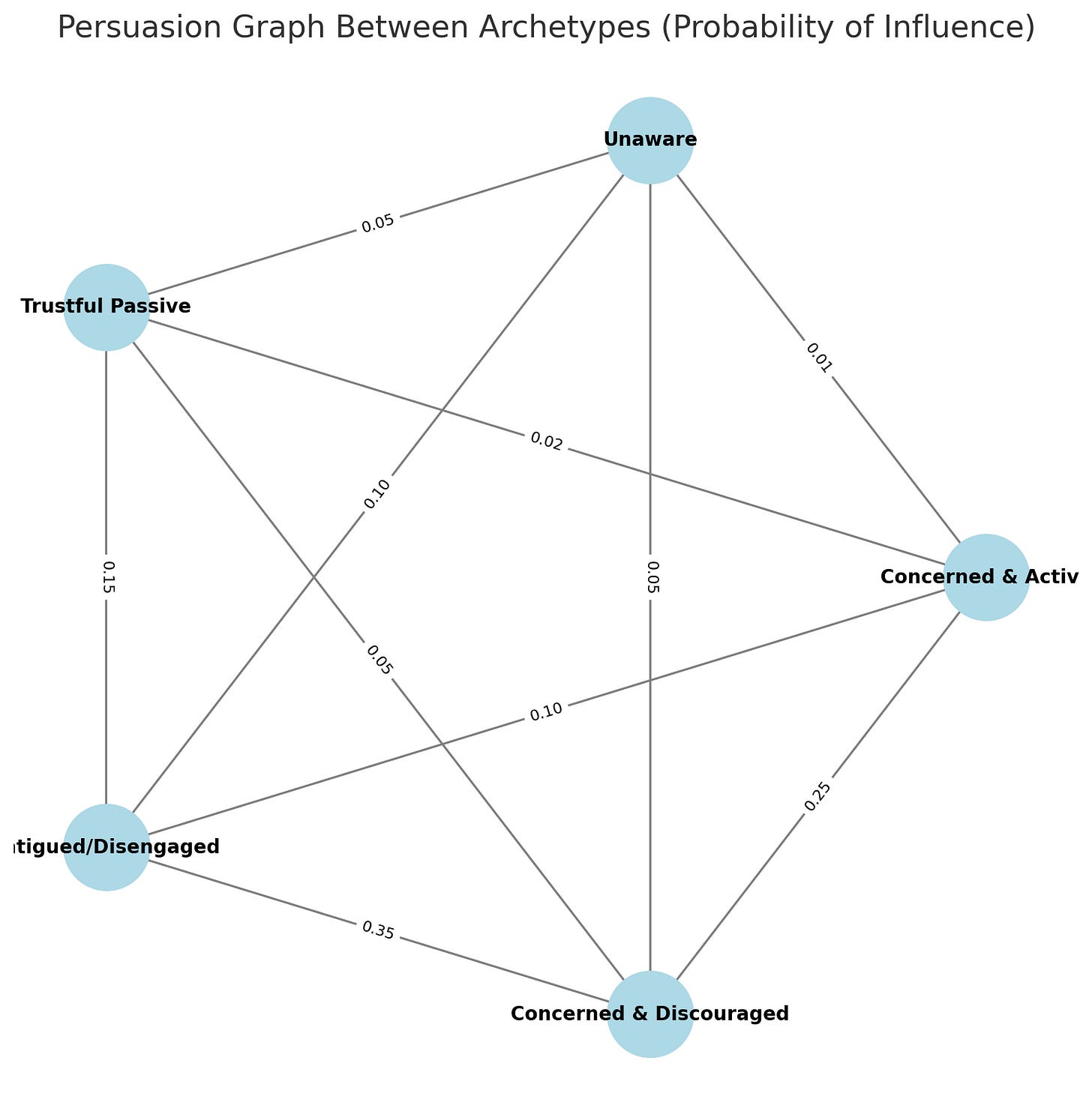

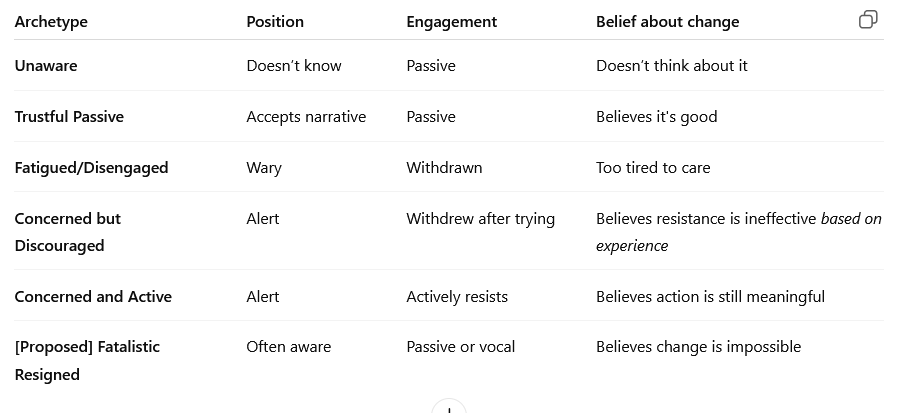
Very good article. Sadly I think there is more people that falls under "type-one" due to the massive psychological operations going on. In my NCI testimony I talk little bit about that but due to time constraint I didn't get a chance to go in full details. Lucky for us, Jason Christfoff's presentation on Day 3 (June 21, 2025) of the NCI Kitchener testimony talks about that in greater details.
I think the taxonomy is interesting and helpful. However, I think that there is another sort of person who does not quite fit: Someone who sees a large array of issues to deal with, and pushes some aside so as not to spread their activity too thinly. On a particular issue they sort of fit into types 3 or 4, but not exactly. They are not tired or discouraged; maybe kind of distracted, but not drained; maybe wary of those who would shut them down, but capable of standing up if it seems like it would be productive to do so. It’s just that there are so many things to deal with and so they carefully choose what to expend their energy on. Perhaps such people are too rare to have a category for them, but maybe not. Do you know such people? Maybe you’re one yourself.